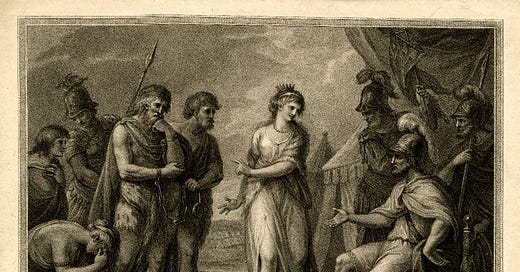Hello and happy Thursday to you 😊
Let’s start with some exciting news that was announced a few weeks ago. In January 2025, a team of researchers sequenced the DNA of over 50 individuals buried in a 2000-year-old cemetery. Using samples from the dense bone around the inner ear, these individuals belonged to the Durotriges tribe, who lived in modern-day Dorset on the south coast of England between 100 BC and 100 AD.
According to lead researcher, Dr Cassidy:
"When we finished the first quite big batch of samples, we immediately saw that there was something special about this site on the screen …The men in this community didn't share a Y chromosome. Rather, individuals shared mitochondrial DNA, which is passed to children from their mothers. If that wasn’t interesting enough, the results showed that more than two-thirds of the individuals were descended from a single maternal lineage, originating from a common female ancestor a few centuries earlier.”
This is obviously super exciting, but it gets better:
“This was a clear signature of matrilocality, or husbands moving to live with their wives’ families – a pattern we’d never seen before in prehistoric Europe.”
The norm in prehistoric Europe (and for much of history, in fact) was patrilocality, which is when a woman moves to her male partner’s community.
The fact that the Durotriges tribe practiced matrilocality is significant for a few reasons:
1. Usually, matrilocality brings with it practices that benefit women in other ways. One of these is through strong communities and elevated community influence. Under patrilocality, women join a brand new community and have to build brand new relationships from scratch, therefore, don’t have the same support networks to lean on.
2. In modern societies that have matrilocality, women tend to be more involved in food production and have higher status and involvement in the local economy. Could this have happened for women of the Durotriges? Cemetery evidence does show that women were buried with high-value items, so it is possible.
3. This is the first evidence of matrilocality in prehistoric Europe which is huge) but what are the chances that the Durotriges were the only ones? I’d say they were pretty slim, tbh.
Since these Celtic peoples did not leave behind any written evidence, what we do know about them (beyond archaeology) comes from the Romans. As I’ve mentioned before, seeing women through the eyes of men is not without its problems. But we do get some interesting insights from Roman writers. Remember that Roman society was deeply patriarchal. When they arrived in Britain, the Romans were genuinely amazed by the relative empowerment of Celtic women.
“Relative” is important here, dear reader. There is no evidence that Celtic Britain was anywhere close to matriarchal. Having said that, this feels like a perfect moment to introduce (or remind) you of the only two named Celtic queens from this period in British history.
First is the one you probably already know - Boudicca, Queen of the Iceni tribe (see the eastern tip of England on the map above). Following the death of her husband, King Prasutagus, around 60 AD, the Romans ignored his will, which had left part of his kingdom to the Roman Emperor Nero and part to Boudicca's daughters. Instead, they annexed the Iceni territory entirely, flogged Boudicca, and sexually assaulted her daughters. Outraged, Boudicca united the Iceni and neighbouring tribes in a full-scale revolt. Boudicca was eventually defeated in battle and died shortly after. Annoyingly, we don’t know the details.
The other Celtic queen is, of course, Cartimandua. Queen of the Brigantes, a large tribe in northern Britain, Cartimandua and Boudicca were alive at the same time, but approached Roman colonialism in very different ways. While Boudicca revolted, Cartimandua allied herself with the newcomers.
Around 51 AD, Cartimandua cemented her loyalty to Rome by capturing and handing over the tribal resistance leader Caractacus, who had sought refuge in her territory after his defeat. The Romans obviously loved this but her own people were less than pleased.
Then, her marriage to King Venutius broke down. Cartimandua divorced him and took his shield-bearer, Vellocatus, as her consort. The idea of Cartimandua literally consorting with a servant was outrageous. A SERVANT, though?! GROSS.
Anyway, this was all the fuel that Venutius needed. He capitalised on the strong anti-Cartimandua vibes, leading multiple rebellions against her. Although initially supported by Roman forces, Cartimandua's hold on power weakened, and Venutius overthrew her around 69 AD.
Again, let me remind you that we see these women through the eyes of Roman writers, never on their own terms, but that doesn’t detract from the importance of their stories.
Until next time,
Kaye x







Loved this post!